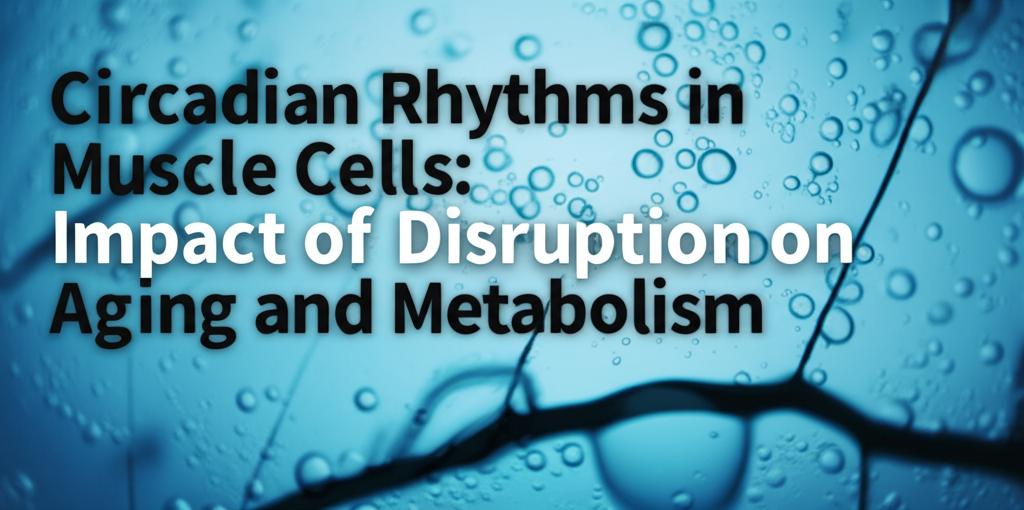Muscle cells possess their own internal clocks that regulate crucial functions, and new research highlights how disrupting these circadian rhythms, such as through shift work, can significantly impact aging and metabolism.
Disruption Accelerates Muscle Aging and Sarcopenia:Recent studies show a strong link between disrupted muscle cell clocks and accelerated muscle aging, a condition known as sarcopenia, which involves the loss of muscle mass and function. The circadian clock within muscle cells manages the balance between protein synthesis (building) and degradation (breakdown). This is vital for maintaining muscle health and integrity.
A key finding is the concept of "nocturnal clearance." During the night, muscle cells activate pathways to identify and remove damaged or defective proteins that have accumulated from daily activity. This process is essential for preventing the buildup of dysfunctional proteins that can impair muscle function and growth. When the muscle's internal clock is not functioning correctly, this clearance mechanism falters. This leads to a premature decline in muscle health, with symptoms similar to those seen in older individuals and shift workers.
Research using zebrafish, which share many genes with humans, demonstrated that disrupting the muscle clock led to premature aging signs. Fish with dysfunctional muscle clocks were smaller, weighed less, and showed reduced physical activity compared to healthy controls. This mimics the muscle decline observed in older humans and highlights a conserved biological mechanism linking circadian disruption and sarcopenia.
Impact on Metabolism:The intrinsic circadian clock in muscle cells plays a critical role in whole-body energy metabolism, including the regulation of glucose, amino acid, and lipid metabolism. Disruption of core clock genes, such as BMAL1 and CLOCK, in muscle cells has been shown to lead to:
- Insulin Resistance and Glucose Intolerance: Muscle-specific knockout of BMAL1 in animal models results in impaired glucose handling and insulin resistance. Even short-term circadian misalignment in humans can rapidly induce insulin resistance, primarily at the skeletal muscle level. This is a significant risk factor for developing type 2 diabetes.
- Altered Lipid Metabolism: Circadian misalignment can disrupt the lipid profile in skeletal muscle, contributing to insulin resistance.
- Impaired Protein Turnover: The muscle clock regulates the daily rhythms of muscle protein synthesis and breakdown. Disruption impairs the crucial nocturnal clearance of damaged proteins, leading to their accumulation and contributing to muscle dysfunction.
- Reduced Metabolic Flexibility: A functional muscle clock helps temporally separate substrate utilization and storage, allowing skeletal muscle to maintain metabolic homeostasis. Disruption diminishes this ability.
The consequences of impaired muscle circadian rhythms extend beyond muscle tissue itself. Because skeletal muscle is a major player in overall metabolism, disruptions can have systemic effects. The impaired clearance of damaged proteins, a hallmark of muscle aging due to circadian disruption, is also implicated in neurodegenerative diseases and other metabolic disorders. This suggests that circadian dysregulation in muscle could contribute to a wider range of age-related health problems.
Factors Contributing to Disruption and Potential Interventions:Modern lifestyle factors such as shift work, irregular sleep schedules, chronic jet lag, and even aging itself can disturb these vital cellular rhythms. This disruption is increasingly recognized as a risk factor for metabolic syndrome, sarcopenia, and frailty.
Research is exploring strategies to mitigate the negative effects of circadian disruption:
- Chrono-nutrition: The timing of nutritional intake, such as protein distribution across meals and time-restricted feeding, shows potential for improving muscle health and entraining peripheral clocks.
- Timed Exercise: The timing of physical activity may also influence its benefits on muscle metabolism and strength, with some evidence suggesting late afternoon exercise could be more effective due to the natural rhythms of clock gene expression in muscles.
- Pharmacological Interventions: Preclinical studies are investigating drugs that target specific clock proteins to potentially restore nocturnal protein breakdown activity and muscle function in circadian-disrupted models.
The circadian clock also influences muscle repair. Studies indicate that muscle injuries heal faster when they occur during an organism's natural waking hours. This is linked to the circadian regulation of inflammatory responses in muscle stem cells and the production of NAD+, a coenzyme crucial for energy metabolism and repair processes. Disruptions to circadian rhythms, common in aging and metabolic conditions like obesity, are associated with diminished muscle regeneration capacity.
In summary, the circadian clocks within muscle cells are fundamental for maintaining muscle health, regulating metabolism, and influencing the aging process. Disruption of these rhythms, often due to modern lifestyle patterns, can accelerate muscle decline, impair metabolic function, and contribute to age-related diseases. Understanding these mechanisms is paving the way for new strategies to promote healthy aging and treat metabolic and muscle disorders.

